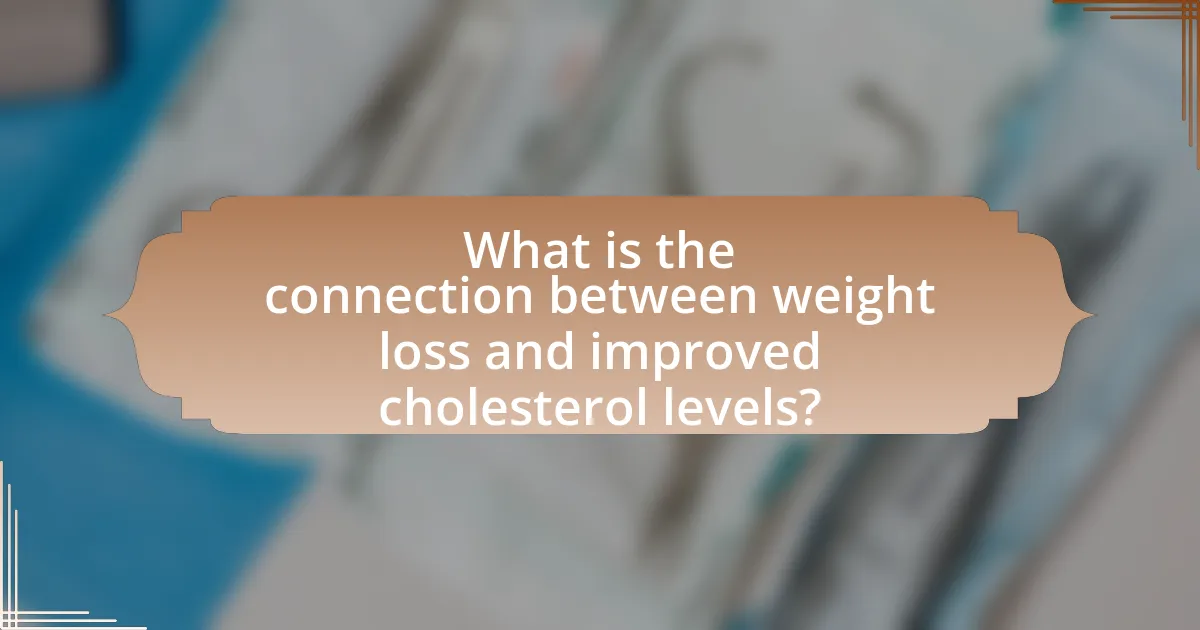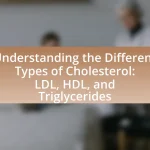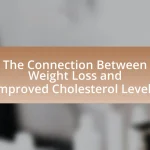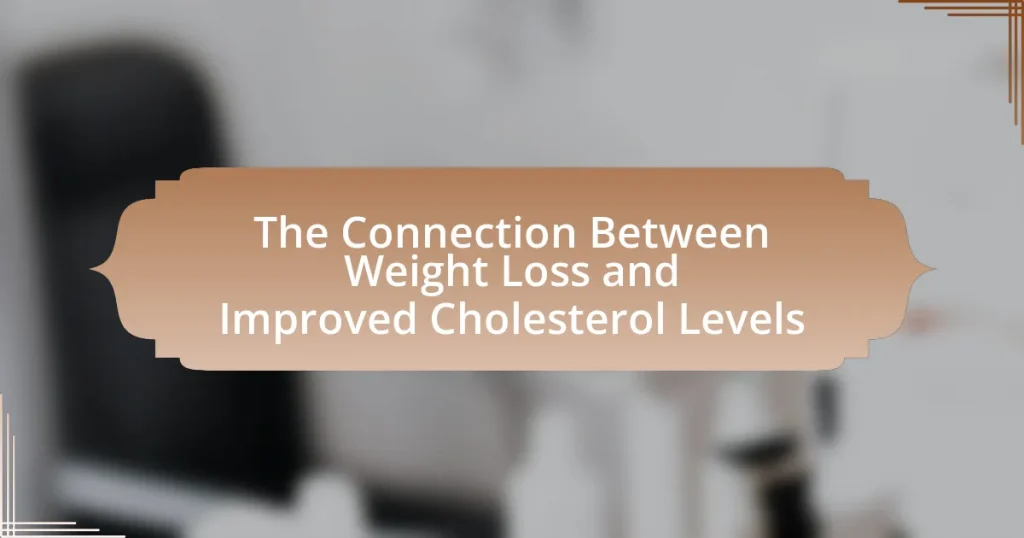The article examines the connection between weight loss and improved cholesterol levels, highlighting how reducing body weight can lead to decreased low-density lipoprotein (LDL) cholesterol and increased high-density lipoprotein (HDL) cholesterol. It discusses the impact of various weight loss methods, including dietary changes and physical activity, on lipid profiles and cardiovascular health. The article also addresses the importance of cholesterol in overall health, the mechanisms behind weight loss and cholesterol improvement, and practical strategies for effective weight management to enhance cholesterol levels. Additionally, it outlines common challenges individuals face in achieving weight loss and offers best practices for monitoring cholesterol during this process.

What is the connection between weight loss and improved cholesterol levels?
Weight loss is directly connected to improved cholesterol levels, as reducing body weight can lead to a decrease in low-density lipoprotein (LDL) cholesterol and an increase in high-density lipoprotein (HDL) cholesterol. Studies indicate that losing as little as 5-10% of body weight can significantly enhance lipid profiles. For instance, a study published in the Journal of Clinical Lipidology found that participants who lost weight experienced a notable reduction in total cholesterol and LDL cholesterol levels, demonstrating the beneficial effects of weight management on cardiovascular health.
How does weight loss influence cholesterol levels?
Weight loss generally leads to improved cholesterol levels by reducing low-density lipoprotein (LDL) cholesterol and increasing high-density lipoprotein (HDL) cholesterol. Studies indicate that losing as little as 5-10% of body weight can significantly lower LDL cholesterol levels, which is associated with a reduced risk of cardiovascular disease. For instance, a study published in the Journal of the American College of Cardiology found that participants who lost weight experienced a notable decrease in total cholesterol and LDL levels, while HDL levels increased. This relationship underscores the beneficial impact of weight loss on cholesterol management and overall heart health.
What types of cholesterol are affected by weight loss?
Weight loss primarily affects low-density lipoprotein (LDL) cholesterol and high-density lipoprotein (HDL) cholesterol. Research indicates that losing weight can lead to a reduction in LDL cholesterol, which is often referred to as “bad” cholesterol, while simultaneously increasing HDL cholesterol, known as “good” cholesterol. A study published in the Journal of Clinical Lipidology found that participants who lost weight experienced significant improvements in their lipid profiles, with a decrease in LDL levels and an increase in HDL levels, demonstrating the beneficial impact of weight loss on cholesterol levels.
How do different weight loss methods impact cholesterol levels?
Different weight loss methods can significantly impact cholesterol levels, often leading to improvements in lipid profiles. For instance, dietary changes such as adopting a Mediterranean diet, which emphasizes healthy fats, fruits, and vegetables, have been shown to lower LDL cholesterol and increase HDL cholesterol. A study published in the American Journal of Clinical Nutrition found that participants following this diet experienced a 10% reduction in LDL cholesterol over six months.
Similarly, regular physical activity, a common component of weight loss strategies, has been linked to favorable changes in cholesterol levels. Research indicates that aerobic exercise can raise HDL cholesterol levels while lowering triglycerides, contributing to overall cardiovascular health. A meta-analysis in the Journal of the American College of Cardiology reported that individuals engaging in moderate-intensity exercise saw an average increase of 5% in HDL cholesterol.
In contrast, rapid weight loss methods, such as very low-calorie diets, may initially lead to a decrease in total cholesterol but can result in unfavorable changes in lipid profiles if not managed properly. A study in Obesity Research showed that participants who lost weight too quickly experienced fluctuations in cholesterol levels, highlighting the importance of sustainable weight loss approaches for long-term benefits.
Overall, the method of weight loss plays a crucial role in determining its effects on cholesterol levels, with balanced diets and regular exercise being the most effective strategies for improving lipid profiles.
Why is cholesterol important for overall health?
Cholesterol is important for overall health because it plays a crucial role in the formation of cell membranes, hormones, and vitamin D. Specifically, cholesterol is essential for synthesizing steroid hormones such as cortisol and sex hormones, which regulate various bodily functions. Additionally, it aids in the production of bile acids that are necessary for digestion and absorption of dietary fats. Research indicates that maintaining balanced cholesterol levels is vital for cardiovascular health, as high levels of low-density lipoprotein (LDL) cholesterol can lead to atherosclerosis, increasing the risk of heart disease. Thus, cholesterol is not only a structural component of cells but also a key player in metabolic processes that are fundamental to maintaining health.
What are the different types of cholesterol and their functions?
There are three main types of cholesterol: low-density lipoprotein (LDL), high-density lipoprotein (HDL), and very low-density lipoprotein (VLDL). LDL is often referred to as “bad” cholesterol because it can lead to the buildup of plaque in arteries, increasing the risk of heart disease. HDL is known as “good” cholesterol as it helps remove LDL cholesterol from the bloodstream, thus reducing the risk of cardiovascular issues. VLDL primarily carries triglycerides, another type of fat in the blood, and high levels can also contribute to plaque formation in arteries. These functions highlight the importance of maintaining a balance between these cholesterol types for optimal heart health.
How does high cholesterol affect cardiovascular health?
High cholesterol negatively impacts cardiovascular health by contributing to the formation of plaque in the arteries, which can lead to atherosclerosis. Atherosclerosis narrows the arteries, restricting blood flow and increasing the risk of heart attacks and strokes. According to the American Heart Association, high levels of low-density lipoprotein (LDL) cholesterol are directly linked to cardiovascular disease, with studies indicating that for every 1% increase in LDL cholesterol, the risk of heart disease increases by approximately 2%. This evidence underscores the critical relationship between elevated cholesterol levels and adverse cardiovascular outcomes.

What are the mechanisms behind weight loss and cholesterol improvement?
Weight loss primarily improves cholesterol levels through mechanisms such as reduced body fat, enhanced insulin sensitivity, and improved lipid metabolism. When individuals lose weight, particularly visceral fat, the body experiences a decrease in the production of low-density lipoprotein (LDL) cholesterol and an increase in high-density lipoprotein (HDL) cholesterol. Research indicates that a weight loss of 5-10% can lead to significant improvements in cholesterol profiles, as evidenced by a study published in the Journal of the American College of Cardiology, which found that weight reduction is associated with favorable changes in lipid levels. Additionally, weight loss enhances insulin sensitivity, which helps regulate lipid metabolism and reduces triglyceride levels, further contributing to improved cholesterol levels.
How does body fat reduction affect lipid profiles?
Body fat reduction positively affects lipid profiles by decreasing levels of triglycerides and low-density lipoprotein (LDL) cholesterol while increasing high-density lipoprotein (HDL) cholesterol. Studies indicate that weight loss of 5-10% can lead to significant improvements in these lipid parameters. For instance, a meta-analysis published in the Journal of Clinical Lipidology found that participants who lost weight experienced a reduction in triglycerides by approximately 20-30 mg/dL and an increase in HDL cholesterol by about 5-10 mg/dL. This evidence supports the conclusion that body fat reduction is beneficial for improving lipid profiles, thereby reducing cardiovascular disease risk.
What role does insulin sensitivity play in cholesterol levels?
Insulin sensitivity plays a crucial role in regulating cholesterol levels by influencing lipid metabolism. When insulin sensitivity is high, the body effectively utilizes insulin to manage glucose and fat storage, leading to lower levels of triglycerides and LDL cholesterol, which are associated with cardiovascular risk. Conversely, low insulin sensitivity, often seen in insulin resistance, can result in elevated triglycerides and LDL cholesterol levels, contributing to a higher risk of heart disease. Research indicates that improving insulin sensitivity through weight loss can significantly lower cholesterol levels, as evidenced by a study published in the Journal of Clinical Endocrinology & Metabolism, which found that weight loss improved insulin sensitivity and subsequently reduced lipid levels in overweight individuals.
How does inflammation relate to weight loss and cholesterol?
Inflammation negatively impacts weight loss and cholesterol levels by promoting insulin resistance and altering lipid metabolism. Chronic inflammation, often associated with obesity, leads to the release of pro-inflammatory cytokines that can hinder the body’s ability to utilize insulin effectively, resulting in increased fat storage and difficulty in losing weight. Additionally, inflammation can disrupt the balance of cholesterol by increasing levels of low-density lipoprotein (LDL) and decreasing high-density lipoprotein (HDL), which are critical for cardiovascular health. Studies have shown that reducing inflammation through lifestyle changes, such as diet and exercise, can improve both weight loss outcomes and cholesterol profiles, highlighting the interconnectedness of these factors.
What lifestyle changes contribute to weight loss and better cholesterol?
Regular physical activity, a balanced diet, and weight management contribute to weight loss and better cholesterol levels. Engaging in at least 150 minutes of moderate aerobic exercise weekly can help reduce body fat and improve lipid profiles. A diet rich in fruits, vegetables, whole grains, and healthy fats, such as those found in nuts and olive oil, has been shown to lower LDL cholesterol and raise HDL cholesterol. Additionally, maintaining a healthy weight through caloric balance is crucial; studies indicate that losing just 5-10% of body weight can significantly improve cholesterol levels.
How does diet impact weight loss and cholesterol levels?
Diet significantly impacts weight loss and cholesterol levels by influencing calorie intake and the types of fats consumed. A balanced diet that is low in saturated fats and high in fiber can promote weight loss and lower LDL cholesterol, which is linked to heart disease. For instance, a study published in the American Journal of Clinical Nutrition found that individuals who followed a Mediterranean diet, rich in fruits, vegetables, whole grains, and healthy fats, experienced greater weight loss and reductions in cholesterol levels compared to those on a standard diet. This evidence supports the notion that dietary choices directly affect both weight management and cholesterol health.
What types of exercise are most effective for weight loss and cholesterol improvement?
Aerobic exercises, such as running, cycling, and swimming, are most effective for weight loss and cholesterol improvement. These activities increase heart rate and promote calorie burning, which aids in weight loss. A study published in the Journal of the American College of Cardiology found that individuals engaging in regular aerobic exercise experienced significant reductions in LDL cholesterol levels and increases in HDL cholesterol levels. Additionally, strength training exercises, like weight lifting, also contribute to weight loss and can improve cholesterol profiles by increasing muscle mass, which enhances metabolic rate.

What are the practical implications of weight loss on cholesterol management?
Weight loss significantly improves cholesterol management by reducing levels of low-density lipoprotein (LDL) cholesterol and increasing high-density lipoprotein (HDL) cholesterol. Studies indicate that a weight loss of 5-10% can lead to a notable decrease in LDL cholesterol levels, which is linked to a lower risk of cardiovascular diseases. For instance, research published in the Journal of the American College of Cardiology found that participants who lost weight experienced an average reduction of 10-15 mg/dL in LDL cholesterol. Additionally, weight loss enhances insulin sensitivity, which further contributes to better lipid profiles. Therefore, practical implications of weight loss include improved cholesterol levels, reduced cardiovascular risk, and enhanced overall metabolic health.
How can individuals effectively lose weight to improve cholesterol levels?
Individuals can effectively lose weight to improve cholesterol levels by adopting a balanced diet, increasing physical activity, and making lifestyle changes. A balanced diet that emphasizes whole foods, such as fruits, vegetables, whole grains, lean proteins, and healthy fats, can lead to weight loss and lower LDL cholesterol levels. Research indicates that losing just 5-10% of body weight can significantly improve cholesterol profiles, as evidenced by a study published in the Journal of the American College of Cardiology, which found that weight loss is associated with reductions in total cholesterol and triglycerides. Additionally, engaging in regular physical activity, such as aerobic exercises and strength training, can enhance weight loss efforts and further improve cholesterol levels by increasing HDL cholesterol, the “good” cholesterol.
What dietary strategies are recommended for weight loss and cholesterol improvement?
A Mediterranean diet is recommended for weight loss and cholesterol improvement. This dietary strategy emphasizes whole foods, including fruits, vegetables, whole grains, lean proteins, and healthy fats, particularly from olive oil and nuts. Research indicates that adherence to a Mediterranean diet can lead to significant reductions in LDL cholesterol levels and promote weight loss due to its focus on nutrient-dense foods and lower calorie density. A study published in the New England Journal of Medicine found that participants following a Mediterranean diet experienced a 30% reduction in cardiovascular events, highlighting its effectiveness in improving cholesterol levels while supporting weight management.
What are some effective exercise routines for weight loss and cholesterol management?
Effective exercise routines for weight loss and cholesterol management include aerobic exercises, strength training, and high-intensity interval training (HIIT). Aerobic exercises, such as brisk walking, running, cycling, and swimming, help burn calories and improve cardiovascular health, which can lower LDL cholesterol and raise HDL cholesterol. Research indicates that engaging in at least 150 minutes of moderate-intensity aerobic activity weekly can significantly aid in weight loss and cholesterol improvement.
Strength training, performed at least twice a week, builds muscle mass, which increases resting metabolic rate and aids in weight loss. Additionally, studies show that strength training can positively influence cholesterol levels by improving overall body composition.
High-intensity interval training (HIIT) combines short bursts of intense activity with rest or low-intensity periods, leading to greater calorie burn in a shorter time. Research published in the Journal of Obesity found that HIIT can effectively reduce body fat and improve lipid profiles, making it a valuable component of an exercise routine aimed at weight loss and cholesterol management.
What common challenges do people face in achieving weight loss for cholesterol improvement?
People commonly face several challenges in achieving weight loss for cholesterol improvement, including dietary restrictions, lack of motivation, and difficulty in maintaining a consistent exercise routine. Dietary restrictions can lead to frustration, as individuals may struggle to find healthy foods that are both satisfying and conducive to weight loss. Lack of motivation often stems from slow progress or plateaus, which can discourage continued effort. Additionally, maintaining a consistent exercise routine is challenging due to time constraints, fatigue, or lack of access to facilities. These factors collectively hinder effective weight loss efforts, which are essential for improving cholesterol levels.
How can individuals overcome plateaus in weight loss?
Individuals can overcome plateaus in weight loss by adjusting their diet and exercise routines. For instance, incorporating a variety of foods can prevent metabolic adaptation, which often occurs when the body becomes accustomed to a specific caloric intake. Research indicates that changing exercise intensity, such as alternating between high-intensity interval training and steady-state cardio, can also stimulate weight loss by increasing calorie expenditure. Additionally, tracking macronutrient ratios and ensuring adequate protein intake can support muscle retention and fat loss, as evidenced by studies showing that higher protein diets can enhance weight loss outcomes.
What support systems are beneficial for maintaining weight loss and cholesterol goals?
Support systems that are beneficial for maintaining weight loss and cholesterol goals include structured weight loss programs, social support networks, and professional guidance from healthcare providers. Structured weight loss programs, such as those based on behavioral therapy, have been shown to help individuals achieve and sustain weight loss while also improving cholesterol levels. Research indicates that participants in these programs often experience greater success due to accountability and access to resources. Social support networks, including family and friends, provide emotional encouragement and motivation, which are crucial for long-term adherence to lifestyle changes. Additionally, professional guidance from dietitians or nutritionists can offer personalized dietary plans that target both weight loss and cholesterol management, leading to more effective outcomes.
What are the best practices for monitoring cholesterol levels during weight loss?
The best practices for monitoring cholesterol levels during weight loss include regular lipid panel testing, maintaining a balanced diet, and tracking dietary intake. Regular lipid panel testing, typically every 3 to 6 months, allows individuals to assess changes in cholesterol levels as they lose weight. A balanced diet rich in fruits, vegetables, whole grains, and healthy fats can positively influence cholesterol levels. Tracking dietary intake using apps or journals helps individuals stay accountable and make informed food choices, which can lead to improved cholesterol profiles. Research indicates that weight loss of 5-10% can significantly lower LDL cholesterol and triglycerides while raising HDL cholesterol, reinforcing the importance of these monitoring practices.










